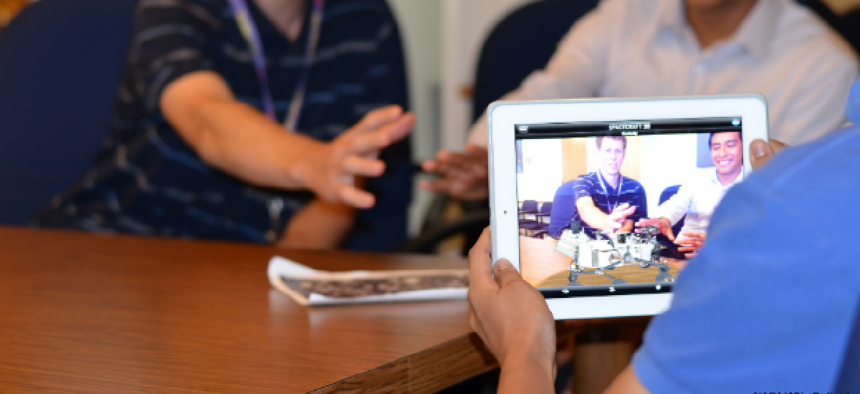NASA's Spacecraft 3D shows what augmented reality can do


Connecting state and local government leaders
The free mobile app can put spaceships in your living room or wherever you point your device, and hints at augmented reality's potential as a training tool.
News flash: Curiosity just found life on Mars!
Of course, Mars was actually my living room floor. And the new life was actually my none-too-amused cat, Bridget. It was all part of the fun of playing with NASA's augmented reality app, Spacecraft 3D, on my tablet.

Spacecraft 3D encounters alien life form.
Augmented reality hit the scene a few years ago when someone figured out how to leverage the cameras in the smartphones, tablets and laptops people carry and use those images as part of an app. The mobile device's camera simply looks out into the world and projects that image onto its screen. Then the app can add things to the picture or live feed so that a user gazing through the screen sees things that aren't really there. In this way, it augments reality.
Many games have picked up on this trend, giving players the chance to shoot giant bugs that seem to be invading the food court at their local mall, or to cover walls with virtual graffiti that can be seen only by others in the same location who are also using the app. But it has serious applications too. A recent report from Deloitte Consulting suggested three hypothetical scenarios where augmented reality could be used in government. AR would make a nice training tool, too, though not many organizations outside of the military have experimented with its uses in that area yet.
NASA, which often enlists new technologies to excite people about its mission, used augmented reality to create its Spacecraft 3D app, available free for Apple iOS and Android.
I downloaded it to a Samsung Galaxy Note 8, a mini-tablet that happened to be in the lab for review. But before I could start to bring spaceships into my reality, I also had to print out a target sheet, which is a key component to augmented reality apps that require precision. In the case of Spacecraft 3D, the exact position of the spaceship needs to be known by the tablet. The paper has a bunch of rocks printed on it and simply keys the program to give the device something to focus on.
Once that is set up, you can begin to import spacecraft into your living room, back yard, car seat or anywhere you can place the target sheet. If you hang the sheet on a wall, you can even bring the spaceships into reality sideways, as the device doesn't really care. All spaceships appear perfectly rendered right there in your living room when you look through the screen, which – though disorienting at first – is really cool. The spaceships available include Voyager, SMAP, Cassini and many others. The two most interactive are Pathfinder and Curiosity, which let you raise the antennas and masts and turn the units around and drive them a little bit.
Using that interactivity, I was able to put the Curiosity rover in a position so that it could look at Bridget, though my cat didn't notice anything out of the ordinary since the vehicle only existed for me as I looked through the tablet's screen. At one point it even ran over her, so I was glad I wasn't controlling the real thing.
As a showcase of what augmented reality can do, the Spacecraft 3D app is pretty impressive. Not only is it fun and educational (and free), but everyone I showed it to couldn't wait to start putting virtual deep space probes into their own homes. And before long, this technology could start showing up in agency training apps as well.




